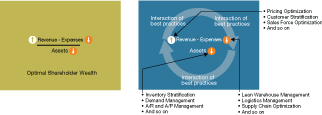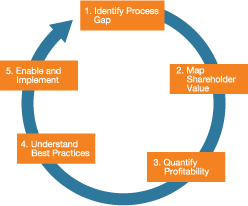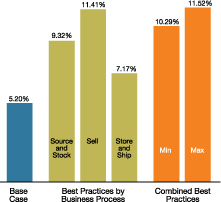The proliferation of mergers and acquisitions throughout the late 1990s and early 2000s spurred the development of "Optimizing Distributor Profitability." The number of acquisitions in wholesale distribution increased 300 percent between 2001 and 2006. The average earnings before interest, taxes, depreciation and amortization (EBITDA) valuation multiples paid for acquired firms went as high as 14, with some spectacular acquisitions, including The Home Depot's purchase of electrical and industrial products distributor Hughes Supply for nearly $3.5 billion in 2006.
Distribution professionals began to consider the feasibility of meeting such high expectations given the aggressive acquisition pace and the growing valuation multiples paid by both strategic and financial buyers. At the same time, some publicly traded distribution firms showed promising results, with EBITDA numbers as high as 20.1 percent (with a median of 7.7 percent) and return-on invested-capital (ROIC) around 30 percent (with a median of 11.3 percent) in 2007.
Simply put, organizations acquired at high EBITDA multiples are at risk if they do not improve their operations enough to justify the purchase price. The question in the late 1990s and early 2000s was whether improvement methods could produce a sufficient impact on the bottom line in an acceptable time window.
Organizations often embark on company-wide business process improvement programs only to find that the return is not immediate or that the efforts do not result in breakthrough bottom line improvements. The acquisition trend and increasing shareholder expectations begged several key questions:
- Can companies achieve the return-on-investment (ROI) requirement implied by double-digit EBITDA multiples in most acquisitions?
- What is the optimal EBITDA number a firm can achieve if it implements the most relevant best practices?
- What best practices differentiate top-performing firms in terms of profitability/ROI?
- Is there a systematic framework of best practice implementation that wholesaler-distributors can adopt?
- If there are so-called secretive best practices, what are they and how can a company get the implementation details?
- Exactly how do best practices enhance shareholder value?
- Where is the elusive link that every CFO is looking for that connects process to profitability?
- How do we assess the process potential of an acquisition target in addition to assessing its financial potential?
| Click and view chart (pdf) Exhibit I-1. The return-on-investment (ROI) equation |
|
 |
Researchers and practitioners at Texas A&M's Supply Chain Systems Laboratory (the research wing of the university's Industrial Distribution program) set out to answer these critical questions in 2007. They organized a consortium of 10 wholesale distribution firms and one distributor association across six lines of trade — building materials, power transmission, electrical, electronics, chemical and architectural metal components and wood stair parts — to discuss the roadblocks these organizations faced when it came to quantifying and prioritizing large-scale improvement projects.
Almost all participants agreed on one fundamental problem: there is a lack of connectivity between a distributor's business activities and the impact of those activities on the firm's financial elements. What's more, their management teams could not clearly justify investments made in day-to-day activities, such as improving warehouse operations, or in long-term strategic initiatives, such as establishing a new distribution center in a different location. The cost of a bad investment simply was not an option given the fierce competition and existing economic conditions. The consortium addressed this need by helping distributors see the connections between business processes and financial drivers.
| Click and view chart (pdf) Exhibit I-2. Optimizing Distributor Profitability methodology |
|
 |
The research was conducted using ROI for key financial drivers — revenue, expenses, and assets — as shown in exhibit I-1. Our premise was that the ROI equation is not so simple; revenue, expenses and assets can be optimized by performing various best practices. Further, implementing several best practices at once produces an interactive effect. For example, an inventory stratification best practice not only affects the assets portion of the equation, but it also affects the pricing optimization best practice and, hence, would have an impact on the revenue portion of the equation as well.
The consortium answered all of the proposed questions using real-world distributor processes and financial structures. The primary research identified the following:
- A logical process framework for understanding and implementing best practices for distributor functions: source, stock (inventory management), store (warehouse management), sell, ship, supply chain planning, and support services. Collectively, this framework was called the "7S Processes."
- A financial framework based on key drivers — growth, profitability, asset efficiency, and cash flow.
- A five-step methodology to assess, identify, and optimize shareholder value: 1) identify process gaps, 2) link to shareholder value, 3) assess profitability, 4) understand best practices, and 5) implement by enabling resources. Exhibit I-2 illustrates this process.
- A one-to-one quantifiable connection between business processes and shareholder value. A Distributor Profitability Framework map (included with the book) illustrates this connection, linking key business processes to shareholder value through a systematic procedure. The map shows that the 7S business processes are intrinsically linked to distributors' financial framework.
| Click and view chart (pdf) Exhibit I-3. Potential profitability for a typical distributor (impact of best practices on EBITDA) |
|
 |
The findings were further validated because companies who join research consortia are likely to be at best practice levels in several categories already. The analysis revealed that typical wholesaler-distributors can double their EBITDA and triple their ROI by implementing best practices across source, stock, sell, store, and ship processes. As shown in exhibit I-3, a distributor with a current EBITDA of 5.2 percent (base case) has the potential to double its EBITDA to 11.52 percent (max) by implementing multiple best practices.
The consortium produced a profitability toolkit (a compendium of best practices across distributor functions), a self-assessment workbook, and the Distributor Profitability Framework.
"Optimizing Distributor Profitability" is written by F. Barry Lawrence, Ph.D., Senthil Gunasekaran and Pradip Krishnadevarajan. The book is a collaboration of the National Association of Wholesaler-Distributors (NAW) and Texas A&M. The excerpt is from the book's introduction and is reprinted with permission of the NAW Institute for Distribution Excellence. For more information, www.naw.org/optimizdistprof

 Celebrating BSCAI's 60th Anniversary eBook
Celebrating BSCAI's 60th Anniversary eBook The Down and Dirty on Cleaning in Virus Season
The Down and Dirty on Cleaning in Virus Season How Surfactant Use is Expanding in Commercial Cleaning
How Surfactant Use is Expanding in Commercial Cleaning